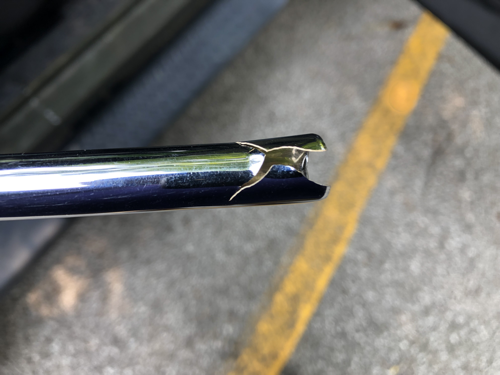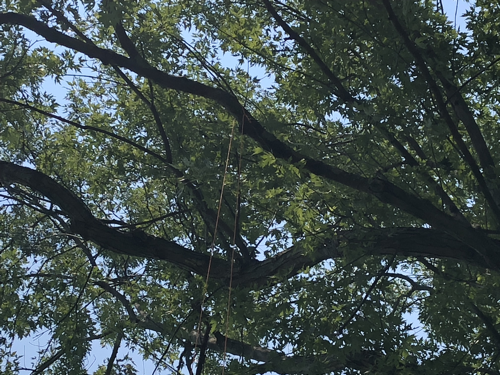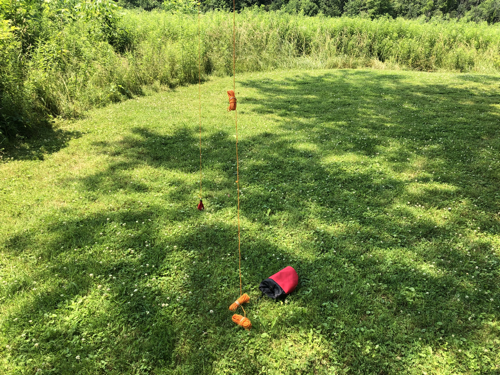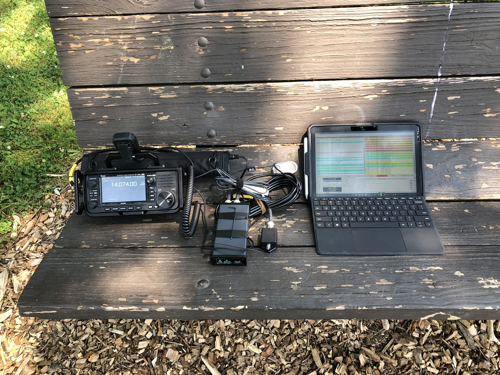Monday, July 05 was a holiday for me, so it made sense to head out into the field for a little radio fun. The IC-705 and assorted gear were already in their pack and ready to go. The destination for the day was to be the Virginia Kendall section of the Cuyahoga Valley National Park. It’s a place that I have been going since I was a kid and I know it very, very well. The general plan was to work from inside the Jeep in the corner of a specific parking lot that has some decent elevation.
The lot was nice and quiet. There were families out and enjoying the day. It was probably 85F when I arrived with some fairly disgusting humidity, but that wasn’t going to impede operations in the least. The MP1 was to be the antenna of the day. It was clamped securely to the cargo cage of the Jeep and I got into the passenger seat to start the tuning process. As I prepared the radio, the sound of metal hitting the ground disrupted the process. The MP1 fell sideways and crashed down whip first, destroying the whip. And “destroy” is the right word.

That put an end to using the MP1 as my antenna of choice for the day. And it changed the base of operations.
Because I keep all of my portable gear in one backpack, I had my Par EndFedz® End Fed Half Wave Antenna with me. But there was no way to deploy it in the parking lot and there weren’t a lot of places nearby in the park that would be great for it. So I thought about Hampton Hills where I’d worked with my dad a few weeks back. It was only a couple of miles away, so I moved. I got the antenna up into the tree quickly and was ready to tune.


It’s only fair to take a moment to sing the praises of this particular antenna. The first time I used it in my yard, it tuned up almost instantly on 40m and 20m. I’ve used it up and down the band with the mAT-705 and it performs well and is consistent. It’s also tiny and nearly invisible when deployed. All in all, I’m thrilled with it.
Getting it into the tree with the arborists line was, as usual, a breeze. The bright orange rope also helps me alert people (and myself) to where it is, though I prefer to operate out of the way of people in general. It isn’t that social interaction isn’t fun, but it does take away from the precious little time I have in the field to work the radio. In any case, the arborists line is a must.
Shortly after tuning the antenna, the computer needed to have its time synched in an authoritative way. My dad convinced me to get one of the little GPS pucks that run about $25. It works really, really well. Yes, simply connecting it to a cell phone takes care of that and it would also be possible to hook it up to the 705 to get GPS time, but the puck is very fast, requires no fiddling, and “Just Works”. It’s nice to have options.

Total time to get from putting the pack down on the bench to actually calling CQ on FT8 was about 10 minutes. Not too bad when considering that the line had to get into the tree and there was a little monkeying around with how the antenna actually sat. I worked about 6 stations. I was heard all across the US, but didn’t seem to get over to Europe at all, though I heard plenty. I do use KC3JXQ/P as my designation when calling CQ. While it may not indicate that I’m running QRP, there is at least the suggestion that the signal isn’t coming from a permanently installed antenna. Lots of discussion on various lists about that and all I can say is that I will always try to hit a portable station if I know they’re portable. It’s just more fun for me.
So what were the lessons of this trip? Always have a Plan B. Having the extra antenna handy and a place to deploy it saved the day. Sure, I only made about 6 contacts, but that’s more than the zero I would have made otherwise. I also took a closer look at the Jeep and found a much better solution for mounting the MP1 in the future. More on that when I get my new whip and fire that up.
![]()